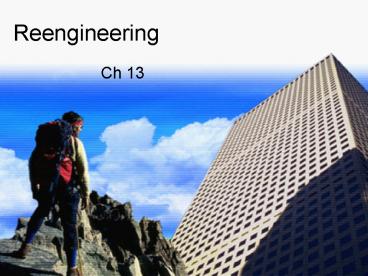Reengineering - PowerPoint PPT Presentation
1 / 7
Title:
Reengineering
Description:
It is time to adopt a new philosophy in America.' Arthur Deming's focus on total quality management (TQM) helped Japan recover after World War II. ... – PowerPoint PPT presentation
Number of Views:21
Avg rating:3.0/5.0
Title: Reengineering
1
Reengineering
- Ch 13
2
History
- Arthur Demings focus on total quality management
(TQM) helped Japan recover after World War II.
- "We have learned to live in a world of mistakes
and defective products as if they were necessary
to life. It is time to adopt a new philosophy in
America."
3
History
- Demings TQM theory met resistance from the
information/computer theory proponents in the
70s. - Michael Hammer introduced the Business Process
Reengineering concept when he wrote that TQMs
focus on eliminating redundancy and streamlining
business processes were essential for success and
productivity.
4
Introduction
- When programs exist without systematic
evaluation, attempts to add programming or
introduce new interventions will often compound
already existing problems. - Without process, impact, and outcome evaluation
methods, innovation is impossible.
5
Solutions?
- Reengineering programs to become the health
resource that they should be. - Demonstrating value added to the business.
- Partnering with other departments or employee
groups and programs and increasing ownership and
program effectiveness. - Reaching deeper into diverse populations with
more efficient services. - Moving stagnant programs forward.
- Fostering an organizational culture that
reinforces healthy lifestyles. - Becoming a part of the business plan not just
that wellness program.
6
Key Elements
- Process Focused
- Registration must be analyzed for efficiency,
duplication, areas of success and improvement - Managing Change and Risk gtgtgt How?
- Change a situational, eliminatory process
- Transition dealing with change
- Documented Improvement
- Be sure to document all measurable elements of
the program
7
Managing Change/Transition
- Determine what individual behavior and attitude
will have to be for the change to work. - Analyze who stands to gain, and who to lose,
something under the new system. - Effectively sell the problem to ensure individual
buy-in. - Provide precontemplators or the disgruntled to
voice their concerns. - Ensure the staff understand change and transition
concepts. - Hold regular meetings to discuss problems.
- Always ensure an free flow of ideas and
suggestions.































